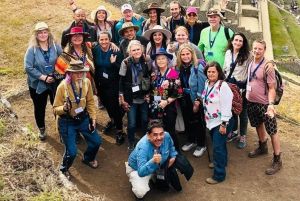“There were so many distractions that I couldn’t relax. How do you stay with your own experience when someone is making noises next to you that are triggering?”
“That’s called somatoemotional release, and it’s a process of healing, release, and unwinding that a person goes through when they’re experiencing the release of mind-body trauma. It’s weird when you’re not used to it, but when you know what it is, it isn’t so triggering,” I explained to my friend.
“Ah, okay. I mean, I tried to take responsibility for my own process and was aware enough to realize it was my trigger that was the problem, not his noises. But it’s really difficult when you’re laying right next to the person, and they’re screaming, grunting, or gyrating.”
“Yep, I get it. But what’s beautiful about that is when you’re in the middle of a group healing process, and it’s a safe enough container, people can really let go. I remember wishing I could let out that primal scream myself. It took me literally decades to feel safe enough to do that in a group. I couldn’t even scream into a pillow at home by myself. I just couldn’t make the sound.”
“Wow, yeah, okay. I’m beginning to understand this now. Thank you,” my friend said.
We recently had an incredible event: a group sound healing. This scene above has also occurred during group breathwork sessions and group teaching sessions I attended during my training as a myofascial and craniosacral therapist.
It’s really important to understand what happens inside people who are experiencing this kind of release so it doesn’t distract you from your own process. In fact, when you understand what’s happening, someone else’s process can help you let go.
During our group author’s journey in Teo, Mexico, I remember lying next to one of my colleagues during our group breathwork session. She began her process and, as a result, was able to let go with some seriously loud primal screams.
OMG, maybe it’s my turn, I thought.
Why does this feel so hard? What are they going to think if I just let it rip?
And there it is, right? It’s the worry about what others will think if they hear you sobbing, screaming, spitting, or whatever other thing happens during intense somato-emotional or myofascial release.
It took me several more minutes to begin to make any sound. I started with a hum. The music is very loud during a breathwork session, making it easier to make noise because your noise is somewhat drowned out by the music. This, for me, is brilliant. I need that to be able to let go of my self-conscious gripping and make noise.
My hum turned to a louder, growl-like noise, which I allowed to morph into a full-on scream. I did it twice. I screamed until my breath emptied from me, and I coughed and then laughed.
Whoa, that felt good!
And no one took off their blindfolds to stare y’all. Nobody cared. They were all in their own process. By the way, blindfolds during breathwork are another brilliant way to stay out of your head and just in your own process.
This was a room full of seasoned healers, though.
So, if you’re new to group healing, I encourage you to talk to healers who’ve dedicated their lives to this journey and begin to understand what it looks and sounds like when trauma is released from the body-mind. It’s intense, profound, and magnificent.
Be curious. Allow yourself to feel everything. Notice the sensations and thoughts. Breathe through them. Don’t clench yourself up with limiting thoughts or beliefs about what you’re seeing, hearing, or noticing. Practice full awareness and non-judgment.
You may just experience something that changes everything.
Happy healing, my brave friends.
By the way, we publish books by healers because we not only speak healer speak, we understand what’s possible when it comes to this journey. Your beautiful, brave words and work are world-changing, and it’s time the world understands what’s possible for healing. We got you and we can’t wait to talk to you about your book or project. Come find us at BraveHealer.com







